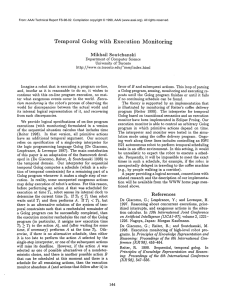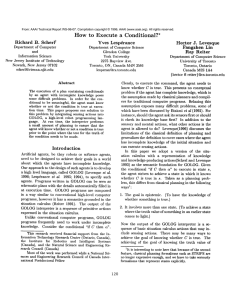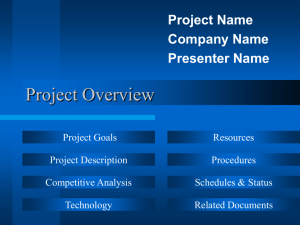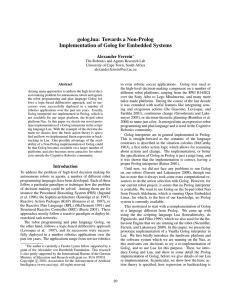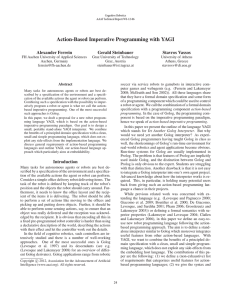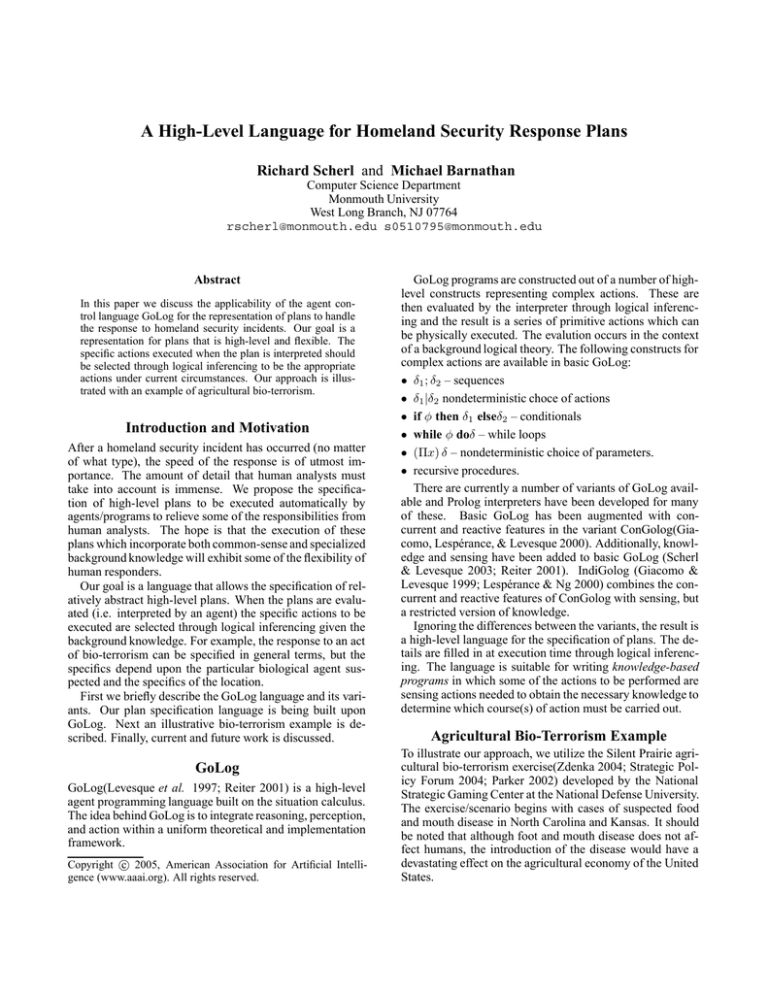
A High-Level Language for Homeland Security Response Plans
Richard Scherl and Michael Barnathan
Computer Science Department
Monmouth University
West Long Branch, NJ 07764
rscherl@monmouth.edu s0510795@monmouth.edu
Abstract
In this paper we discuss the applicability of the agent control language GoLog for the representation of plans to handle
the response to homeland security incidents. Our goal is a
representation for plans that is high-level and flexible. The
specific actions executed when the plan is interpreted should
be selected through logical inferencing to be the appropriate
actions under current circumstances. Our approach is illustrated with an example of agricultural bio-terrorism.
Introduction and Motivation
After a homeland security incident has occurred (no matter
of what type), the speed of the response is of utmost importance. The amount of detail that human analysts must
take into account is immense. We propose the specification of high-level plans to be executed automatically by
agents/programs to relieve some of the responsibilities from
human analysts. The hope is that the execution of these
plans which incorporate both common-sense and specialized
background knowledge will exhibit some of the flexibility of
human responders.
Our goal is a language that allows the specification of relatively abstract high-level plans. When the plans are evaluated (i.e. interpreted by an agent) the specific actions to be
executed are selected through logical inferencing given the
background knowledge. For example, the response to an act
of bio-terrorism can be specified in general terms, but the
specifics depend upon the particular biological agent suspected and the specifics of the location.
First we briefly describe the GoLog language and its variants. Our plan specification language is being built upon
GoLog. Next an illustrative bio-terrorism example is described. Finally, current and future work is discussed.
GoLog
GoLog(Levesque et al. 1997; Reiter 2001) is a high-level
agent programming language built on the situation calculus.
The idea behind GoLog is to integrate reasoning, perception,
and action within a uniform theoretical and implementation
framework.
c 2005, American Association for Artificial IntelliCopyright gence (www.aaai.org). All rights reserved.
GoLog programs are constructed out of a number of highlevel constructs representing complex actions. These are
then evaluated by the interpreter through logical inferencing and the result is a series of primitive actions which can
be physically executed. The evalution occurs in the context
of a background logical theory. The following constructs for
complex actions are available in basic GoLog:
• δ1 ; δ2 – sequences
• δ1 |δ2 nondeterministic choce of actions
• if φ then δ1 elseδ2 – conditionals
• while φ doδ – while loops
• (Πx) δ – nondeterministic choice of parameters.
• recursive procedures.
There are currently a number of variants of GoLog available and Prolog interpreters have been developed for many
of these. Basic GoLog has been augmented with concurrent and reactive features in the variant ConGolog(Giacomo, Lespérance, & Levesque 2000). Additionally, knowledge and sensing have been added to basic GoLog (Scherl
& Levesque 2003; Reiter 2001). IndiGolog (Giacomo &
Levesque 1999; Lespérance & Ng 2000) combines the concurrent and reactive features of ConGolog with sensing, but
a restricted version of knowledge.
Ignoring the differences between the variants, the result is
a high-level language for the specification of plans. The details are filled in at execution time through logical inferencing. The language is suitable for writing knowledge-based
programs in which some of the actions to be performed are
sensing actions needed to obtain the necessary knowledge to
determine which course(s) of action must be carried out.
Agricultural Bio-Terrorism Example
To illustrate our approach, we utilize the Silent Prairie agricultural bio-terrorism exercise(Zdenka 2004; Strategic Policy Forum 2004; Parker 2002) developed by the National
Strategic Gaming Center at the National Defense University.
The exercise/scenario begins with cases of suspected food
and mouth disease in North Carolina and Kansas. It should
be noted that although foot and mouth disease does not affect humans, the introduction of the disease would have a
devastating effect on the agricultural economy of the United
States.
Among the many actions that need to be taken initially
are:
• Notify the FBI since terrorism is suspected.
• Notify state officials and farm companies.
• Determine to which states N. Carolina cattle are shipped
and notify the governors.
• Send sample to Plum Island facility for analysis.
• Start initial containment strategy (quarantine zones).
• Notify USDA, FDA, DHS, and DOD.
• Enact regional containment strategy.
• Check to see if there was “chatter” about a FMD act of
terrorism being planned.
Further actions depend upon the results of these initial actions.
Here is a piece of the GoLog like plan. The plan specifies
a module that determines to which states animal f (in our
case cattle) are sent from a (in our case North Carolina) and
performs the appropriate notification:
proc det notify(a)
While ¬knows(∀xState(x) → Considered(x))
(Πx).state(x)?;
If ¬Kwhether(Shipto(f, a, x)) then
sense ship(f, a, x) endif;
If Knows(Shipto(f, a, x)) then
notify(f, a, x) endif;
endWhile;
endProc
Note that each state is considered in turn. The sensing action which needs to consult databases of shipments is not
executed if it is already known whether or not shipments are
made to that state. Otherwise, the sensing action is executed
and then if it is known that cattle are shipped to that state,
the notification is executed.
As a further example, consider the gathering of evidence
that the incident is a result of criminal/terrorist activity. This
demands the ability to access information from a variety of
sources. These include records of “chatter”, databases on
the biowarfare/bioterrorism interests/capabilities of different countries, and sources with information on biological
agents. Integrating and fusing the data available from the
different sources (with different terminologies, schemas) demands reasoning with background knowledge about the nature of the information provided by each source.
Current and Future Work
Currently, an implementation of the above scenario is being built within the agent platform Jade
(http://jade.tilab.com). The controlling agent
executes the GoLog plan for responding to the potential incident of agricultural Bio-Terrorism. In doing so, the agent
requests information from various other agents (written in
Java) and sends commands to be “executed” by yet other
Java agents.
Future work will include.
• Development of natural-language facilities to make the
construction of GoLog programs possible for those who
do not know the details of the language.
• Integration of reasoning about information annotated in
semantic web ontology languages such as OWL.
• Adding a probabilistic representation of belief, potentially
inaccurate information, and probabilistic effects of actions.
Summary
In conclusion, the work so far demonstrates that GoLog
is a promising basis on which to develop a high-level language for the representation of plans suitable for responses
to homeland security incidents. Further experimentation
with different scenarios is needed to determine which features need to be present in a suitable language for this application.
Acknowledgments
This work has been supported by the Knowledge Fusion
Center of the Army Research Laboratory under contract
number DAAD-03-2-0034. We thank Yves Lesperance for
helpful conversations on GoLog and its variants.
References
Giacomo, G. D., and Levesque, H. J. 1999. An incremental
interpreter for high-level programs with sensing. In Logical
Foundations for Cognitive Agents: Contributions in honor
of Ray Reiter. Springer-Verlag. 86–102.
Giacomo, G. D.; Lespérance, Y.; and Levesque, H. J. 2000.
ConGolog, a concurrent programming language based on
the situation calculus. Artificial Intelligence 109–169.
Lespérance, Y., and Ng, H. 2000. Integrating planning
into reactive high-level robot programs. In Proceedings
of the Second International Cognitive Robotics Workshop,
49–54.
Levesque, H.; Reiter, R.; Lespérance, Y.; Lin, F.; and
Scherl, R. B. 1997. Golog: A logic programming language
for dynamic domains. Journal of Logic Programming.
McCarthy, J. 1968. Programs with common sense. In Minsky, M., ed., Semantic Information Processing. The MIT
Press. chapter 7, 403–418.
Parker, H. 2002. Agricultural Bioterrorism: A Federal
Strategy to Meet the Threat. Washington, D.C.: Institute
for National Strategic Studies.
Reiter, R. 2001. Knowledge in Action: Logical Foundations for Specifying and Implementing Dynamical Systems.
Cambridge, Massachusetts: The MIT Press.
Scherl, R., and Levesque, H. 2003. Knowledge, action,
and the frame problem. Artificial Intelligence 144:1–39.
Strategic Policy Forum. 2004. Silent prairie participant
guide. unpublished exercise materials prepared by the National Defense University.
Zdenka, W. 2004. Silent prairie crisis simulation. Presentation on April 14, 2004 at Monmouth Univerisity using
materials prepared by the National Defense University.

